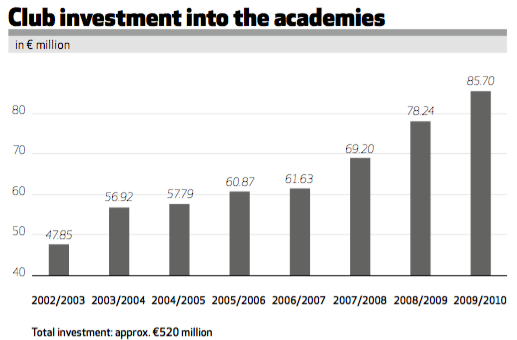Titles, triumphs and tears. The German national team stands for major success and huge emotions, for sporting excellence and excellent integration. And for millions of fans, it stands for unforgettable moments.
On 13 July 2014, Germany defeated Argentina 1-0 at Rio de Janeiro’s Maracanã Stadium in the World Cup final. Their success was not a fluke; it was rooted in a system that was set in place 12 years prior to their fourth World Cup title.
 IN THE PHOTO: GERMAN PLAYERS CELEBRATING AFTER WINNING THE 2014 WORLD CUP, PHOTO CREDIT: FLICKR/himanisdas
IN THE PHOTO: GERMAN PLAYERS CELEBRATING AFTER WINNING THE 2014 WORLD CUP, PHOTO CREDIT: FLICKR/himanisdas
At the 2000 UEFA European Championships, Germany had quite a poor showing having not made it out of the group stage. Germany was in ‘crisis mode.’ There was a lack of a foundation and change needed to occur. Where did the German’s look to make a change? Their youth.
In March 2011, the DFL Deutsche Fußball Liga GmbH (German Football League) released a report titled “10 Years of Academies: Talent pools of top-level German Football.” In his introduction, Dr. Reinhard Rauball, the President of the League Association, wrote:
Most lately this superior performance by our national team has shown that the measures decided upon by the League Association and the 36 professional clubs in Germany ten years ago were correct. For all clubs, the compulsory introduction of academies for young players in 2001 was the building block which laid the way to a successful future for German football.
From around 2002 to 2010, Germany invested approximately €520 million into its youth development system. The money went towards academies across the country, specifically to clubs in the top two leagues in Germany, the Bundesliga and the Bundesliga 2. Most academies have teams for players aged 12 to 23 and a defined system on how to develop elite players. Incorporating education is also a vital part of each academy. The 2011 report cites a survey led by Dr. Uwe Harttgen, the director of the Werder Bremen Academy and former Bundesliga player, which shows that a greater proportion of the members in the academies are high school graduates than the national average. Lastly, these academies are frequently assessed and are rewarded financially based off of their ratings.
PHOTO CREDIT: “10 Years of Academies” (DFL Deutsche Fußball Liga GmbH)
How has this new and well-defined system enhanced German soccer? Does having a well structured soccer youth development system really create international success?
Firstly, after lacking younger players, the average age of players in the Bundesliga dropped from 2001/02 to 2010/11 by 1.32 years and the number of German players in the professional game in Germany increased. This has lead to a greater pool of talented young Germans to pick from for the national team. In March 2011, every national team down to the Under-15s saw a large proportion of its players come through a German academy. Even in the senior national team, 19 out of 22 players were products of the academy system.

PHOTO CREDIT: “10 Years of Academies” (DFL Deutsche Fußball Liga GmbH)
When the report was released, more than half of the 525 players in the Bundesliga came from a German academy and 107 of those 275 athletes played for the club where they were developed. Having players grow together within an academy helps build synergy; when members of a national youth team advance together, their symbiotic relationship helps forge strong squads.
Related article: “UNPARALLELED PASSION: THE POWER OF EURO 2016”
In 2014, many of the top players on the German national team came through Bundesliga academies and were products of the system that was put in place. Interestingly, five players who were on Germany’s 2009 Under-21 European Championship winning side started the 2014 World Cup final in Brazil. These five players also came through German academies! (Manuel Neuer, from Schalke 04’s academy, Benedikt Höwedes, Schalke 04, Jérôme Boateng, Hertha BSC, Mats Hummels, Bayern Munich, Mesut Özil, Schalke 04).
The average age on the German team in the 2000 European Championships was roughly 28.5 years while the average age in the 2014 World Cup for Germany was 26.3 years. New and younger faces found their way into the squad and continue to do so. After dealing with an aging pool of players, the youth now is becoming stronger and more prevalent.
More academy graduates can be found in the German team that will be playing at the Rio 2016 Olympics which begins in the coming weeks. The teams that will participate in the competition are limited to selecting under-23 players (born on or after 1 January, 1993) and three over-23 players. With many players deciding to opt out of playing for their national team so they can stick with their club teams during the Olympics, the selection pool is limited further. Nevertheless, 17 out of 18 of the German players currently play professionally in Germany and most went through a German academy — once again a testament to the successful system.
Horst Hrubesch has announced his 18-man Olympic squad for @Rio2016_en! 🇩🇪 #Rio2016 pic.twitter.com/dhnrasl0RR
— German Football (@DFB_Team_EN) July 15, 2016
This German model has an eye on the future and on the present successes of the national team. This structure did not just promise success for the 2014 World Cup, but it has created a well-oiled machine that can produce more and more successful players as the years pass.
For a full mindmap behind this article with articles, videos, and documents see #SoccerDev
Currently, according to TransferMarkt.co.uk, in the top 25 most valuable players list, there are three players who are products of German academies: Özil, who currently plays for Arsenal FC in England, Thomas Müller from Bayern Munich’s academy, and Toni Kroos who came through FC Hansa Rostock’s ranks and now plays for Real Madrid in Spain.
A well-structured soccer youth development system really can bring international success and the Germans have proven that. Even though Germany lost in the semi-finals of this summer’s Euro 2016, their system can assure that they will be back and possibly even better when the 2018 World Cup in Russia comes around.
 IN THE PHOTO: GERMAN SUPPORTERS IN 2006, PHOTO CREDIT: FLICKR/Uwe Hermann
IN THE PHOTO: GERMAN SUPPORTERS IN 2006, PHOTO CREDIT: FLICKR/Uwe Hermann
A less quantifiable strength that the German’s have, is the passion that a majority of the nation has for the sport of soccer. On the Deutscher Fussball-Bund’s website, they note the enthusiasm around the national team in Germany:
Sold out stadiums for home games are the norm, excited fans creating a sea of black, red and gold flags are a familiar sight. Even at home or at public viewings, the amount of support is huge. No other spectacle brings the masses together in front of a TV screen than a match involving a selection of Germany’s best footballers.
The question becomes whether other countries trying to develop their youth players and find success can copy the German model?
Yes, similar success can be attained but it is most definitely not a change that can occur over night. With bigger countries, it could also take much longer than it took Germany. A country needs to have citizens who are passionate about soccer, like in Germany, and it needs to be united in attempting to make progress. With solid leadership, properly invested capital, a strong structure in place, and bonds between players as they rise through the ranks, other countries can begin to develop their own international superstars and find successes one competition at a time.
The German national team’s reputation was seeded in years of hard work and success. As Gary Lineker, former English soccer player and current sports broadcaster, said,
Football is a simple game; 22 men chase a ball for 90 minutes and at the end, the Germans win.
Recommended reading: “FOOTBALL VS FOOTBALL: TWO OPPOSING MODELS”
_ _














